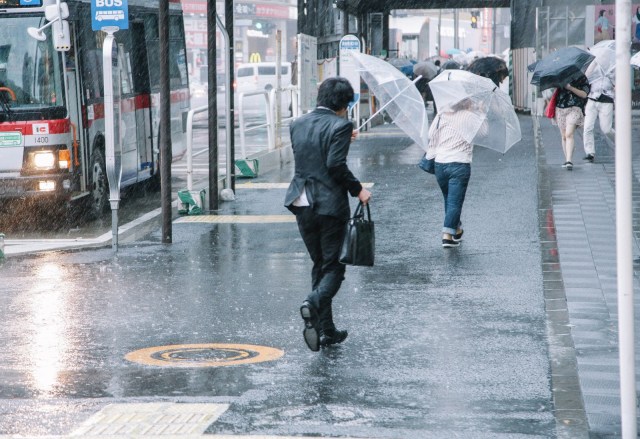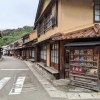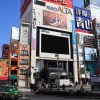
Haneda Airport one of the areas damaged by strong winds and torrential rain.
A powerful typhoon passed through Japan early this morning, travelling along the coast of Shizuoka and Kanagawa prefectures before making landfall in Tokyo’s neighbouring Chiba Prefecture just before 5:00 a.m.
As the typhoon approached the mainland, stores and amusement parks, including Tokyo Disneyland, closed earlier than usual, and rail services and flights in the area were suspended. Weather forecasters cautioned for people to stay indoors while authorities warned that Typhoon Faxai could bring record winds to the capital.
▼ The path of the typhoon as it passed through the Tokyo area.
関東では台風に本当にお気を付け下さい.強い台風15号は今日9日5時前に千葉市付近に上陸,関東南部に記録的な暴風をもたらしています.関東では朝にかけて暴風が続く見込み.大雨による浸水・冠水等も発生,水害にも厳重に警戒を.屋外は極めて危険です.台風が過ぎ去るまで安全確保してお過ごし下さい pic.twitter.com/jT0WJj0RSb
— 荒木健太郎 (@arakencloud) September 8, 2019
When the typhoon arrived in the early hours of the morning, coastal areas around Shizuoka Prefecture’s Izu Peninsula were the first to sustain damage.
▼ The aftermath at Shimoda in Shizuoka Prefecture.
故郷の母から送られてきた、台風被害の様子。伊豆下田。風が強かったようです。被害が少しでも小さかったことを祈ります。#台風15号 #台風被害 pic.twitter.com/apoU5HfCoR
— るんこ (@runko_nabenomae) September 8, 2019
The port city of Yokohama, in Tokyo’s neighbouring Kanagawa Prefecture, was the next to be hit by strong winds and rain.
https://twitter.com/nanozz123/status/1170753914087469056▼ Cars and containers were toppled in the storm.
知り合いから送られてきた現在の横浜港付近です#台風15号 pic.twitter.com/IQk4sWZajN
— メシエ37 (@splatoon_M37) September 8, 2019
Buildings in the area also sustained damage. This scene shows the effects of the typhoon along National Route 16, a highway belt around Tokyo that links the major capital cities of Chiba, Saitama and Yokohama.
国道16号線足場が取れかけとる。こんな台風初めてだ。#台風15号 pic.twitter.com/tRNBV2LZ8H
— Daisuke (@otone_d2) September 8, 2019
Flooding affected areas in downtown Tokyo and the wider Tokyo Metropolis. This video shows the road outside Nishi-waseda Station in Shinjuku.
新宿は副都心線の西早稲田駅前ですが、道路が冠水しています。#台風15号 pic.twitter.com/Rr7FZBcGaY
— 空水りょーすけ(コーラのハブ空港) (@soramizuryosuke) September 8, 2019
▼ This video shows the roads in Koto City.
江東区、東雲付近道路冠水#台風15号 pic.twitter.com/8dyTGXlmHX
— やまさん (@h4Q2JN8ke8tIhDc) September 8, 2019
Haneda International Airport was hit by torrential rain and 155 kilometre-an-hour (96 miles an hour) winds that damaged structures and caused flooding.
https://twitter.com/candama/status/1170799628523950080 https://twitter.com/Hamu_hey0623/status/1170773317784989697羽田空港第1ターミナル駐車場、改修工事の足場が崩れてる#台風15号 pic.twitter.com/j2j7y6Xp9S
— yuji saito (@saitochihuahua) September 8, 2019
羽田空港、水没しとるやんけ pic.twitter.com/ztpurciRgN
— 茸本 朗(たけもとあきら) 「野食ハンター茸本朗ch」公開中!! (@tetsuto_w) September 8, 2019
Roads in and around the area were blocked and closed to traffic, stranding many commuters at the terminal overnight.
羽田空港の駐車場、工事用足場が崩壊しとる… pic.twitter.com/iCgthsx3S9
— スカイ (@sky_fd3s) September 8, 2019
羽田空港に用があるのですが、京急、京急バス共に動かないので徒歩。
— 九鳥 (@hatokudori) September 8, 2019
一枚目は旧環八空港二丁目付近
二枚目空港脇環八。
どっちも閉鎖して復旧中。#京急バス#羽田空港 pic.twitter.com/tT7HhkWTT2
羽田空港国際線→環八、空港西インター方面行けなくて悲惨でした。
— ℑ𝔫𝔣𝔦𝔫𝔦𝔱𝔢 𝔍𝔲𝔰𝔱𝔦𝔠𝔢 (@S_T_A_Y_G_O_L_D) September 8, 2019
国際線方面に転回するのはかなり辛いです。 pic.twitter.com/4ys2pO860E
Chiba Prefecture, where the typhoon made landfall, was the hardest hit, with a number of buildings sustaining damage.
https://twitter.com/Scallop24/status/1170843250569007109▼ A damaged roof at Higashi-Chiba Station.
東千葉駅の屋根 吹っ飛んでる#台風15号 pic.twitter.com/fbSaWQTPYg
— シリウス🤟モルちゃん (@siriusu2815) September 8, 2019
JR東千葉駅これ使えないだろ pic.twitter.com/WXsL94SFyx
— デスマーク (@makugiruda) September 8, 2019
▼ The sea wall at a popular fishing spot in Chiba.
横浜 福浦岩壁
— 爆釣・爆益ドリーム (@2012globe) September 9, 2019
休みの日は多くの釣り人が釣りを楽しむポイント
僕も何度か釣りをしましたが…
早朝上陸した
台風15号の被害で岩壁が倒れてます
また近隣の建物にも多大な被害が…#台風#台風15号 pic.twitter.com/4yGJFxkr24
▼ Trees were uprooted…
ポケGOでジム取りに近くの公園行ったら、大木がポッキリ折れてたΣ(゚Д゚)#台風 #台風15号 pic.twitter.com/kFTT6nYswn
— ウストラノッポ (@usutoranoppo) September 8, 2019
▼ Vending machines toppled over…
自販機が倒れてた…#台風 #台風15号 pic.twitter.com/XF6R7ci4W9
— ウストラノッポ (@usutoranoppo) September 8, 2019
▼ And rooftops blew away in the fierce winds.
#台風15号 風おさまってきたから2階の天井見に行ったら完全に天井が飛んでた pic.twitter.com/r5fMpKPTAa
— 白黒猫 (@nyannko0401) September 8, 2019
▼ The windows shattered on the third floor of this five-storey apartment.
https://twitter.com/kingsma45602711/status/1170802133823709184▼ Walls collapsed and balconies were blown off the sides of houses.
https://twitter.com/kkk0721pen/status/1170804992577376257爆音と共にベランダ吹き飛んだ#台風15号 pic.twitter.com/rudvK9Khhy
— ぐりぽん (@tontorosu) September 8, 2019
▼ Debris on roads around the Aeon shopping mall at Narita, near Narita International Airport in Chiba Prefecture.
成田イオン付近やーばい! #台風15号 pic.twitter.com/wu50hQUHkq
— Eazy-P (@Eazy_pp) September 8, 2019
According to Tokyo Electric Power Company, which services the Kanto region, along with Yamanashi Prefecture and the eastern portion of Shizuoka Prefecture, damage to power lines, like these ones at Chiba, caused power outages at approximately 930,000 households.
千葉の県道24号 電柱折れてるとテンション高い電話がまたきたw#台風15号 pic.twitter.com/7wGY5j2NR0
— piedpiper【 】 (@piedpiper0202) September 8, 2019
千葉県鴨川市の方からの映像。
— MJ#8 (@tokyo_8_mj) September 8, 2019
電柱が倒れまくって木まみれらしいです。この後気温が高くなるので更に注意です⚠️ #台風15号 pic.twitter.com/cNhoYIPCnM
Train services in and around Tokyo were suspended from roughly 10:00 p.m. last night. While the Tokaido Shinkansen service began running at 7:40 a.m. after a slight delay, most of the city’s rail lines, including the Yamanote loop line, were scheduled to restart at 8:00 a.m.
【山手線 内・外回り 運転再開見込 10:00】
— とれいんふぉ 首都圏エリア (@Trainfo) September 9, 2019
山手線は、台風15号接近に伴う線路設備点検の影響で、内・外回り電車で運転を見合わせています。多数の倒木が発見されているため、再開見込は9:00から変更となりました。 pic.twitter.com/7s5qMASMfT
However, after inspecting the rail lines and removing fallen trees and branches, the 8:00 a.m. start time was pushed back to 10:00 a.m., with most services resuming from 10:15 a.m.
#台風15号 #運転見合わせ
— いたずらなS (@itazuranazura) September 8, 2019
大宮駅の電光掲示板 pic.twitter.com/epS0AVkYzS
According to the Fire and Disaster Management Agency, five people across Shizuoka and Kanagawa Prefectures sustained minor injuries as a result of the typhoon. While Typhoon Faxai has now passed through the Kanto region and out to the Pacific Ocean, news reports warn residents to remain vigilant as rain is expected to continue through Tuesday, with seven-metre (23-foot) high waves off the coast of Kanto and the Izu Peninsula.
Source: Tenki Japan, Jiji Press
Featured image: Pakutaso
● Want to hear about SoraNews24’s latest articles as soon as they’re published? Follow us on Facebook and Twitter!

 Typhoon Faxai strands thousands at Narita Airport in Japan【Pics & Video】
Typhoon Faxai strands thousands at Narita Airport in Japan【Pics & Video】 Typhoon Trami batters Japan, hits close to Tokyo with fierce winds 【Photos & Videos】
Typhoon Trami batters Japan, hits close to Tokyo with fierce winds 【Photos & Videos】 Typhoon Jebi hits Japan, blows away cars, roofs, and building facades 【Pics & Videos】
Typhoon Jebi hits Japan, blows away cars, roofs, and building facades 【Pics & Videos】 Typhoon Hagibis turns Tokyo into an eerie ghost town【Pics, Video】
Typhoon Hagibis turns Tokyo into an eerie ghost town【Pics, Video】 X Japan’s Yoshiki apologizes for donating “only” 10 million yen after hometown is hit by typhoon
X Japan’s Yoshiki apologizes for donating “only” 10 million yen after hometown is hit by typhoon McDonald’s new Happy Meals offer up cute and practical Sanrio lifestyle goods
McDonald’s new Happy Meals offer up cute and practical Sanrio lifestyle goods All-you-can-drink Starbucks and amazing views part of Tokyo’s new 170 meter-high sky lounge
All-you-can-drink Starbucks and amazing views part of Tokyo’s new 170 meter-high sky lounge Super Nintendo World expansion gets delayed for several months at Universal Studios Japan
Super Nintendo World expansion gets delayed for several months at Universal Studios Japan Studio Ghibli releases new action figures featuring Nausicaä of the Valley of the Wind characters
Studio Ghibli releases new action figures featuring Nausicaä of the Valley of the Wind characters McDonald’s Japan releases a pancake pie for new retro kissaten coffeeshop series
McDonald’s Japan releases a pancake pie for new retro kissaten coffeeshop series The oldest tunnel in Japan is believed to be haunted, and strange things happen when we go there
The oldest tunnel in Japan is believed to be haunted, and strange things happen when we go there Enjoy Kyoto (Part 3) — The ultimate breakfast? Try $45 rice porridge at a 400-year-old restaurant
Enjoy Kyoto (Part 3) — The ultimate breakfast? Try $45 rice porridge at a 400-year-old restaurant Such recognition! Official doge meme dog manhole cover installed in Japan【Photos】
Such recognition! Official doge meme dog manhole cover installed in Japan【Photos】 South Korean media wants the world to know that “cherry blossoms originated there”
South Korean media wants the world to know that “cherry blossoms originated there” A Japanese vending machine perfect for samurai
A Japanese vending machine perfect for samurai More foreign tourists than ever before in history visited Japan last month
More foreign tourists than ever before in history visited Japan last month Disney princesses get official manga makeovers for Manga Princess Cafe opening in Tokyo
Disney princesses get official manga makeovers for Manga Princess Cafe opening in Tokyo Starbucks reopens at Shibuya Scramble Crossing with new look and design concept
Starbucks reopens at Shibuya Scramble Crossing with new look and design concept Beautiful new Final Fantasy T-shirt collection on the way from Uniqlo【Photos】
Beautiful new Final Fantasy T-shirt collection on the way from Uniqlo【Photos】 Is the new Shinkansen Train Desk ticket worth it?
Is the new Shinkansen Train Desk ticket worth it? Foreign English teachers in Japan pick their favorite Japanese-language phrases【Survey】
Foreign English teachers in Japan pick their favorite Japanese-language phrases【Survey】 Studio Ghibli glasses cases let anime characters keep an eye on your spectacles
Studio Ghibli glasses cases let anime characters keep an eye on your spectacles Beautiful Sailor Moon manhole cover coasters being given out for free by Tokyo tourist center
Beautiful Sailor Moon manhole cover coasters being given out for free by Tokyo tourist center Studio Ghibli releases Kiki’s Delivery Service chocolate cake pouches in Japan
Studio Ghibli releases Kiki’s Delivery Service chocolate cake pouches in Japan Japan’s bone-breaking and record-breaking roller coaster is permanently shutting down
Japan’s bone-breaking and record-breaking roller coaster is permanently shutting down New definition of “Japanese whiskey” goes into effect to prevent fakes from fooling overseas buyers
New definition of “Japanese whiskey” goes into effect to prevent fakes from fooling overseas buyers Our Japanese reporter visits Costco in the U.S., finds super American and very Japanese things
Our Japanese reporter visits Costco in the U.S., finds super American and very Japanese things Studio Ghibli unveils Mother’s Day gift set that captures the love in My Neighbour Totoro
Studio Ghibli unveils Mother’s Day gift set that captures the love in My Neighbour Totoro Domino’s Japan now sells…pizza ears?
Domino’s Japan now sells…pizza ears? New Japanese KitKat flavour stars Sanrio characters, including Hello Kitty
New Japanese KitKat flavour stars Sanrio characters, including Hello Kitty One of Tokyo’s most famous meeting-spot landmarks is closing for good
One of Tokyo’s most famous meeting-spot landmarks is closing for good Kyoto creates new for-tourist buses to address overtourism with higher prices, faster rides
Kyoto creates new for-tourist buses to address overtourism with higher prices, faster rides Sales of Japan’s most convenient train ticket/shopping payment cards suspended indefinitely
Sales of Japan’s most convenient train ticket/shopping payment cards suspended indefinitely Sold-out Studio Ghibli desktop humidifiers are back so Totoro can help you through the dry season
Sold-out Studio Ghibli desktop humidifiers are back so Totoro can help you through the dry season Japanese government to make first change to romanization spelling rules since the 1950s
Japanese government to make first change to romanization spelling rules since the 1950s Ghibli founders Toshio Suzuki and Hayao Miyazaki contribute to Japanese whisky Totoro label design
Ghibli founders Toshio Suzuki and Hayao Miyazaki contribute to Japanese whisky Totoro label design Doraemon found buried at sea as scene from 1993 anime becomes real life【Photos】
Doraemon found buried at sea as scene from 1993 anime becomes real life【Photos】 Tokyo’s most famous Starbucks is closed
Tokyo’s most famous Starbucks is closed One Piece characters’ nationalities revealed, but fans have mixed opinions
One Piece characters’ nationalities revealed, but fans have mixed opinions We asked a Uniqlo employee what four things we should buy and their suggestions didn’t disappoint
We asked a Uniqlo employee what four things we should buy and their suggestions didn’t disappoint Princesses, fruits, and blacksmiths: Study reveals the 30 most unusual family names in Japan
Princesses, fruits, and blacksmiths: Study reveals the 30 most unusual family names in Japan Flood victims send SOS tweets on Twitter in wake of Typhoon Hagibis
Flood victims send SOS tweets on Twitter in wake of Typhoon Hagibis Commuter chaos around Tokyo during peak hour after Typhoon Trami hits Japan 【Pics & Video】
Commuter chaos around Tokyo during peak hour after Typhoon Trami hits Japan 【Pics & Video】 Explosions, toppled trucks, massive sea waves all part of Typhoon Jebi’s destructive force【Vids】
Explosions, toppled trucks, massive sea waves all part of Typhoon Jebi’s destructive force【Vids】 High pollen levels in Eastern Japan create pretty rainbow suns
High pollen levels in Eastern Japan create pretty rainbow suns Message to Japanese media: “Stop asking people to open their fridges during a blackout!”
Message to Japanese media: “Stop asking people to open their fridges during a blackout!” Happy New Year! Japan ranks top spots to view the first sunrise of 2019
Happy New Year! Japan ranks top spots to view the first sunrise of 2019 Yayoi Kusama’s Yellow Pumpkin washed away during typhoon in Japan
Yayoi Kusama’s Yellow Pumpkin washed away during typhoon in Japan Dragon Ball fans all over the world pitch in with amazing fan art to pay tribute to Goku Day
Dragon Ball fans all over the world pitch in with amazing fan art to pay tribute to Goku Day Strong earthquake hits Hokkaido in Japan, dozens missing and injured
Strong earthquake hits Hokkaido in Japan, dozens missing and injured Typhoon Hagibis turns skies in Japan purply pink, makes people fear the end is nigh
Typhoon Hagibis turns skies in Japan purply pink, makes people fear the end is nigh Frightening video shows the effect of typhoon winds on Ferris wheel in Japan
Frightening video shows the effect of typhoon winds on Ferris wheel in Japan Snow Sakura in Japan: A magical hanami cherry blossom viewing experience【Pics & Video】
Snow Sakura in Japan: A magical hanami cherry blossom viewing experience【Pics & Video】 Stranded passengers on Shinkansen bullet train served out-of-date bread during typhoon
Stranded passengers on Shinkansen bullet train served out-of-date bread during typhoon Rain? No Problem! Not even impending typhoon can keep away fans of J-POP singer Nicholas Edwards
Rain? No Problem! Not even impending typhoon can keep away fans of J-POP singer Nicholas Edwards
Leave a Reply